#enewetak atoll
Text
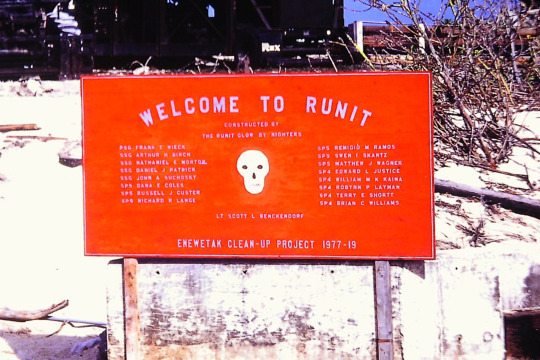
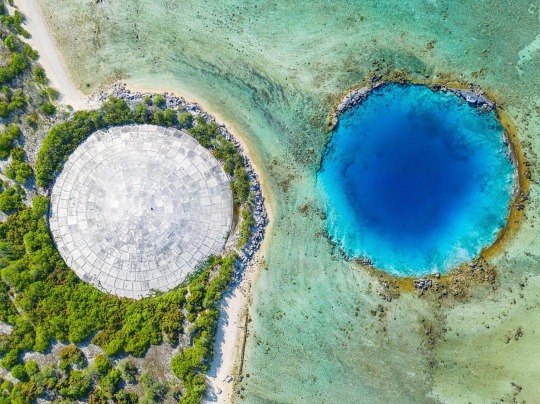
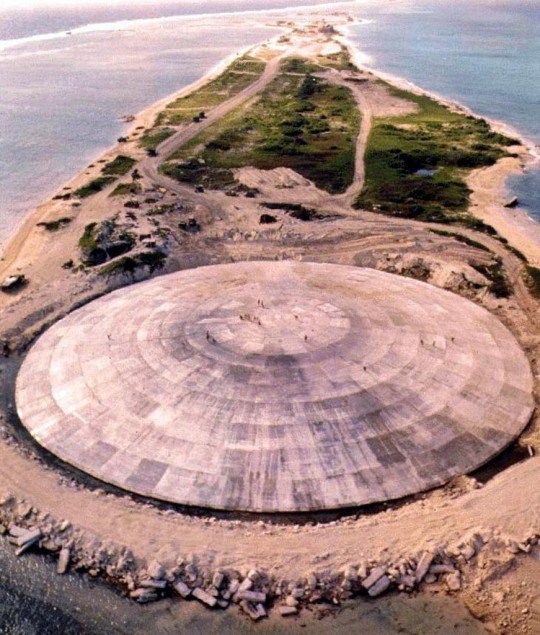


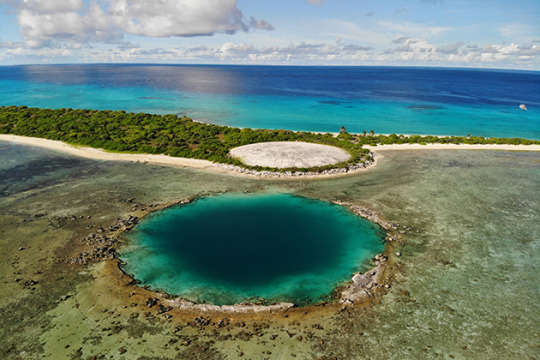

#ruinit dome#marshall islands#enewetak atoll#nuclear#nuclear test#cactus dome#hardtack 1#cactus shot#may 6th 1958#operation hardtack
4 notes
·
View notes
Text
trying to unpack the history of nuclear testing is actually insane because you'll be thinking you're reading a map wrong for like an hour and then you double check the goverment archives and its like, oh! i cant find elugelab island because it's gone! the united states fucking blew it up!

#a whole island now just a smoking crater in the enewetak atoll#whats even worse is that the radioactive fallout hurt more people living in/near the area than vaporizing their fucking island did
137 notes
·
View notes
Text
FUN FACT!
the first ever hydrogen bomb detonated (Operation Ivy: Shot Mike) completely vaporized the island it was detonated on, leaving a giant undersea crater in its place. there was an island there, and now it's just fucking gone.

The island was Elugelab in the Enewetak Atoll
Before the Ivy Mike test:

After the Ivy Mike test:
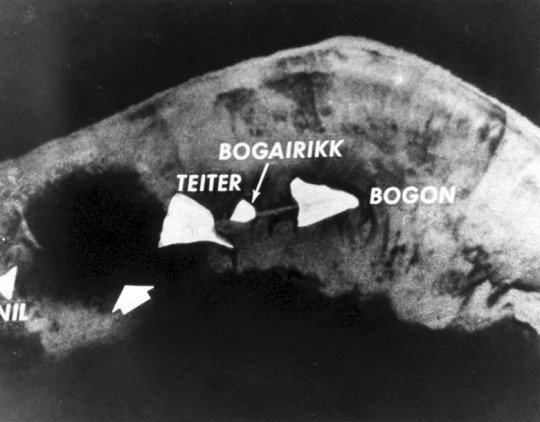


the thing about the Ivy Mike test, though, is that the bomb was too big, impractical, and heavy to carry in an airplane, afix to a rocket, or fire from a canon. still, the blast had a yield of 10.4 megatons, rivaled only by the infamous Castle Bravo test (US 15 megatons), the B-41/ Mk-41 Bomb ( US 25 megatons), and the Tsar Bomba test (USSR 50 megatons).
The rest of these bombs can be dropped from airplanes. The Tsar Bomba design was, however, never put into production as a practical weapon and was simply intended to be a one-off exercise with the goal of creating the largest yeild atomic weapon in history. (it succeeded)
#world history#us history#atomic testing#hydrogen bomb#castle bravo#ivy mike#tsar bomba#infodump#spin#special interest
276 notes
·
View notes
Text
If we’re talking about nuclear justice, please don’t forget the Marshall Islands.
Many people have already pointed out how the Oppenheimer film glosses over the effects of nuclear testing on Indigenous communities in the United States, and it’s undeniable that more people need to know about this. More attention also needs to be paid to the Marshall Islands, where the legacy of US nuclear testing still affects the Marshallese people to this day. Most Americans don’t even know where the Marshall Islands is—let alone what the US government did there during the Cold War.
Between 1946 and 1958, the United States detonated 67 nuclear weapons on the Marshall Islands, which was then a US trust territory. The tests yielded the same level of radiation as 7,000 Hiroshima-sized atomic bombs, or 1.6 Hiroshima bombs every day for 12 years. The US government didn’t even evacuate some islanders from close proximity to the testing grounds. The fallout—which spread across the islands and beyond—caused deaths, miscarriages, stillbirths, radiation sickness, cancer, and many other health problems, with high cancer rates persisting to this day. Whole islands remain uninhabitable, and generations have been displaced.
It gets even worse. The US government knew that certain islands were too dangerous for human habitation and resettled the Marshallese there anyway; then US scientists studied the effects of radiation on them without their knowledge or consent in a secret program called Project 4.1. The US government secretly brought radioactive waste from Nevada and buried it in a concrete dome on Enewetak Atoll that is now vulnerable to erosion from the rising seas. And the US military also used the Marshall Islands for at least a dozen biological weapons tests. The US government did all of this to the Marshall Islands while it was a trust territory under US protection.
But in the decades since nuclear testing ended—even since the Marshall Islands’ independence in 1986—it has never received full compensation from the United States. Never.
There is a lot more that everyone should know about this history, and I recommend starting here to learn more:
624 notes
·
View notes
Note
Thank you for letting me do this, really~~~
Like you mentioned in another post, this isn't specifically about oppenheimer or any narratives it portrays but the wider discussion that's been resurging around usamerican imperialism, nuclear weapons and the military/militarization in general. And this is so very long so I apologise.
The fact of the matter is, even after all the "lessons" learnt from bombing Hiroshima and Nagasaki, the us wanted to do further testing to see the full extent of the impact of nuclear weapons. These tests were carried out in the Marshall Islands in the Pacific, which was already heavily militarized by this point.
As usual when it comes to military interventions and imperialism by core nations, these tests were framed as a necessity "for the greater good", and to "end all wars", even framing its supposed necessity through religious narratives (which, well, christian missionary efforts).
There were 67 tests conducted from 1946 to 1958, and some of the weapons tested like the Bravo bomb dropped on March 1, 1954 over Bikini Atoll were many times more powerful than the ones used in WWII. As expected, these tests completely destroyed the Marshall Islands, from the ocean to the atmosphere to the land. So much radioactive fallout, so much devastation and literally uninhabitable to any living being.
I want to talk specifically about one of the most atrocious aspects of this whole ordeal which is that while the usamerican authorities evacuated the Marshallese people in Bikini and Enewetak during the 1948-52 testing period (operations sandstone, greenhouse and ivy) to nearby islands, they failed to do so for operation castle series begun in 1954. The relocated populations suffered as well, since there weren't enough resources on the islands they were resettled in to sustain this extra population, and of course, the nuclear fallout would affect them even though no weapons were directly tested in these islands.
The impact of the bravo bomb detonated over Bikini was mainly on the people from Rongerik, Rongelap and Ailinginae atolls, who were not evacuated until after the bomb was detonated at which point they were already exposed to high levels of radiation. In fact, the Rongelapese people were basically used as human test subjects as they were relocated back to Rongelap in 1957 where they remained until 1985 when they had to evacuate themselves.
The us actually declared Rongelap safe and that there were no long term effects from nuclear fallout in order to relocate them. Edward teller himself has gone on interviews to declare how little of an impact the bravo test has had on human lives. Iirc the documents regarding the tests were only declassified in the 70s, so Marshallese people were deliberately kept in the dark about the cause of the illnesses they were experiencing due to nuclear fallout. Here is Lijon Eknilang, a Rongelapese survivor talking about her experiences:
In June 1957, when we did return, we saw changes on our island. Some of our food crops, such as arrowroot, completely disappeared. Makmok, or tapioca plants, stopped bearing fruit. What we did eat gave us blisters on our lips and in our mouths and we suffered terrible stomach problems and nausea. Some of the fish we caught caused the same problems. These were things that had not happened before 1954. Our staple foods had never made us ill. We brought these problems to the attention of the doctors and officials who visited us. They said we were preparing the foods incorrectly, or that we had fish poisoning. We knew that was impossible because we had been preparing and surviving from these foods for centuries without suffering from the problems that appeared after 1954.
It has always been interesting to me that even the people who were not on Rongelap in 1954, but who went there with us in 1957, began to experience the same illnesses we did in later years. Foreign doctors and other officials called those people the “control group,” and we were told the sickness of that group proved our illnesses were common to all Marshallese. We did not believe that, and we learned only recently that the “control group” had come from areas that had also been contaminated by radioactivity from the weapons tests.
The usamerican authorities to this day do not acknowledge how serious and how much of an impact the nuclear weapons have left on the Marshall Islands and its people. There is no acknowledgement of the fact that people outside of the Enewetak, Utrik, Bikini and Rongelap atolls during testing were affected even when they show effects of radiation. There is no acknowledgement of just how much destruction they've brought upon these islands (also keeping in mind that animals were not evacuated). And of course, there is no acknowledgement of the fact that none of this was necessary in the first place (even if it can ever be called necessary). It was basically a large scale human experiment done for the sake of science and the "greater good", with little to no concern about the impact it would leave on the people of Oceania.
Oh, and there's also a huge crater left on Enewetak from the testing that's basically leaking nuclear waste into the soil, still contaminating the flora and fauna in area and beyond. There's so much spending by the us military in the Pacific region, especially now with the whole AUKUS agreement, but nothing has been done to properly contain this waste. Or actually address the violation of Marshallese people's human rights due to nuclear weapons testing. There has never really been any talks of reparations either, and whatever money and resources the us has spent has been woefully inadequate.
While the testing stopped decades ago, this is only a part of the ongoing militarization of Oceania by the US (and associated core and semi-periphery nations). Of course, this is all framed as selfless efforts by the us to prevent wars (which it always seems to be doing), for the greater good of humanity, to take us into further advancement and so on. Lastly, to mention a sliver of the role science has played in all of this: they were celebrating the discovery of new elements after the ivy mike detonation (1952), while people were suffering the impact of ongoing nuclear testing, and iirc, they were actually hoping to discover new elements from these nuclear reactions, so who's to say that these weapons were not made as a part of the race to discover elements, aka scientists' version of a dick measuring contest.
Sources and for more info for anyone interested:
Barbara Rose-Johnston. Nuclear Disaster: The Marshall Islands Experience and Lessons for a Post-Fukushima World [where I got the quote and most of the info from]
April L. Brown. No Promised Land: The Shared Legacy of the Castle Bravo Nuclear Test
Carl Zimmer. Nuclear Tests Marked Life in Earth with a Radioactive Spike [the sheer scope of the radioactive fallout from bravo]
Kit Chapman. Element Hunting in a Nuclear Storm
Edward Teller interview
.
243 notes
·
View notes
Text
Please reblog for a bigger sample size!
If you have any fun fact about the Marshall Islands, please tell us and I'll reblog it!
Be respectful in your comments. You can criticize a government without offending its people.
22 notes
·
View notes
Text
On a spring day in 1978, a fisherman caught a tiger shark in the lagoon surrounding Enewetak Atoll, part of the Marshall Islands in the north Pacific. That shark, along with the remains of a green sea turtle it had swallowed, wound up in a natural history museum. Today, scientists are realizing that this turtle holds clues to the lagoon’s nuclear past—and could help us understand how nuclear research, energy production, and warfare will affect the environment in the future.
In 1952, the world’s first hydrogen bomb test had obliterated a neighboring island—one of 43 nuclear bombs detonated at Enewetak in the early years of the Cold War. Recently, Cyler Conrad, an archeologist at Pacific Northwest National Laboratory, began investigating whether radioactive signatures of those explosions had been archived by some particularly good environmental historians: turtles.
“Anywhere that nuclear events have occurred throughout the globe, there are turtles,” Conrad says. It’s not because turtles—including sea turtles, tortoises, and freshwater terrapins—are drawn to nuclear testing sites. They’re just everywhere. They have been mainstays of mythology and popular culture since the dawn of recorded history. “Our human story on the planet is really closely tied to turtles,” Conrad says. And, he adds, because they are famously long-lived, they are uniquely equipped to document the human story within their tough, slow-growing shells.
Collaborating with researchers at Los Alamos National Laboratory, which was once directed by J. Robert Oppenheimer, Conrad was able to use some of the world’s most advanced tools for detecting radioactive elements. Last week, his team’s study in PNAS Nexus reported that this turtle, and others that had lived near nuclear development sites, carried highly enriched uranium—a telltale sign of nuclear weapons testing—in their shells.
Turtle shells are covered by scutes, plates made of keratin, the same material in fingernails. Scutes grow in layers like tree rings, forming beautiful swirls that preserve a chemical record of the turtle’s environment in each sheet. If any animal takes in more of a chemical than it’s able to excrete, whether through eating it, breathing it in, or touching it, that chemical will linger in its body.
Once chemical contaminants—including radionuclides, the unstable radioactive alter egos of chemical elements—make their way into scute, they’re basically stuck there. While these can get smeared across layers in tree rings or soft animal tissues, they get locked into each scute layer at the time the turtle was exposed. The growth pattern on each turtle’s shell depends on its species. Box turtles, for example, grow their scute outward over time, like how humans grow fingernails. Desert tortoise scutes also grow sequentially, but new layers grow underneath older layers, overlapping to create a tree ring-like profile.
Because they are so sensitive to environmental changes, turtles have long been considered sentinels of ecosystem health—a different kind of canary in the coal mine. “They’ll show us things that are emergent problems,” says Wallace J. Nichols, a marine biologist who was not involved in this study. But Conrad’s new findings reveal that turtles are also “showing us things that are distinct problems from the past.”
Conrad’s team at Los Alamos handpicked five turtles from museum archives, with each one representing a different nuclear event in history. One was the Enewetak Atoll green sea turtle, borrowed from the Bernice Pauahi Bishop Museum in Honolulu, Hawaii. Others included a Mojave desert tortoise collected within range of fallout from the former Nevada Test Site; a river cooter from the Savannah River Site, which manufactured fuel for nuclear weapons; and an eastern box turtle from Oak Ridge, which once produced parts for nuclear weapons. A Sonoran desert tortoise, collected far from any nuclear testing or manufacturing sites, served as a natural control.
While working at Los Alamos, Conrad met isotope geochemist and soon-to-be coauthor Jeremy Inglis, who knew how to spot even the most subtle signs of nuclear exposure in a turtle shell. They chose to look for uranium. To a geochemist, this might initially feel like an odd choice. Uranium is found everywhere in nature, and doesn’t necessarily flag anything historically significant. But with sensitive-enough gear, uranium can reveal a lot about isotope composition, or the ratio of its atoms containing different configurations of protons, electrons, and neutrons. Natural uranium, which is in most rocks, is configured very differently from the highly enriched uranium found in nuclear labs and weapons.
To find the highly enriched uranium hidden among the normal stuff in each turtle shell sample, Inglis wore a full-body protective suit in a clean room to keep his uranium from getting in the way. (“There’s enough uranium in my hair to contaminate a picogram of a sample,” he says.) Inglis describes the samples like a gin and tonic: “The tonic is the natural uranium. If you add lots of natural uranium tonic into your highly enriched uranium gin, you ruin it. If we contaminate our samples with natural uranium, the isotope ratio changes, and we can’t see the signal that we’re looking for.”
The team concluded that all four turtles that came from historic nuclear testing or manufacturing sites carried traces of highly enriched uranium. The Sonoran desert tortoise that had never been exposed to nuclear activity was the only one without it.
They collected bulk scute samples from three of their turtles, meaning that they could determine whether the turtle took in uranium at some point in its life, but not exactly when. But the researchers took things a step further with the Oak Ridge box turtle, looking at changes in uranium isotope concentrations across seven scute layers, marking the seven years of the turtle’s life between 1955 and 1962. Changes in the scutes corresponded with fluctuations in documented uranium contamination levels in the area, suggesting that the Oak Ridge turtle’s shell was time-stamped by historic nuclear events. Even the neonatal scute, a layer that grew before the turtle hatched, had signs of nuclear history passed down from its mother.
It’s unclear what this contamination meant for the turtles’ health. All of these shells were from long-dead animals preserved in museum archives. The best time to assess the effects of radionuclides on their health would have been while they were alive, says Kristin Berry, a wildlife biologist specializing in desert tortoises at the Western Ecological Research Center, who was not involved in this study. Berry adds that further research, using controlled experiments in captivity, may help figure out exactly how these animals are taking in nuclear contaminants. Is it from their food? The soil? The air?
Because turtles are nearly omnipresent, tracing nuclear contamination in shells from animals living at various distances from sites of nuclear activity may also help us understand the long-term environmental effects of weapons testing and energy production. Conrad is currently analyzing desert tortoise samples from southwestern Utah, collected by Berry, to better relate exposure to radionuclides (like uranium) to their diets over the course of their lives. He also hopes that these findings will inspire others to study plants and animals with tissues that grow sequentially—like mollusks, which are also found in nearly all aquatic environments.
The incredible migratory patterns of sea turtles, which sometimes span the entire ocean (as anyone familiar with Finding Nemo may recall), open up additional opportunities. For example, sea turtles forage off the Japanese coast, where in 2011 the most powerful earthquake in Japan’s history caused a tsunami that led to a chain reaction of failures at the Fukushima Daiichi Nuclear Power Plant. With lifespans of up to 100 years, many of those turtles are likely still alive today, carrying traces of the disaster on their backs.
Recently, the Japanese government started slowly releasing treated radioactive water from the Fukushima Daiichi plant into the Pacific Ocean. Scientists and policymakers seem to hesitantly agree that this is the least bad option for disposing of the waste, but others are more concerned. (The Chinese government, for instance, banned aquatic imports from Japan in late August.) Through turtle shells, we may better understand how the plant’s failure, and the following cleanup efforts, affect the surrounding ocean.
The bodies of these creatures have been keeping score for millennia. “For better or for worse, they get hit by everything we do,” Nichols says. Maybe, he adds, “the lesson is: Pay more attention to turtles.”
50 notes
·
View notes
Photo

All countries that have and had at some point nuclear warheads
by u/ASWDsEuclides
Some Atolls that were too small for the map:
Johnston Island
Christmas Island (1)
Christmas Island (2)
Malden Island
Mururoa Island
Fangataufa island
Bikini Atoll
Enewetak Island
Mururoa Island
Monte Bello Island
113 notes
·
View notes
Text
“Then, after all of that, the people of the Marshall Islands underwent what Genz has described as one of the most violent histories of the twentieth century.
The Pacific War brought air raids and hunger, and when the war was over the American military began twelve years of nuclear weapons testing on the atolls of Bikini and Enewetak at the northern end of the island chain.
During those years, sixty-seven atomic and thermonuclear bombs were detonated; one of them, called “Castle Bravo,” created a blast a thousand times the magnitude of the Hiroshima and Nagasaki blasts. When Castle Bravo exploded on March 1, 1954, it completely obliterated three nearby islands, and the atoll of Rongelap some hundred miles away, which had not been evacuated, was hit with the radiation fallout. For a day and a night its islanders were blanketed in snowlike ash and began experiencing radiation sickness, including severe burns. After a few days, they were finally evacuated, then returned in 1957 despite the continued risks. Some three hundred people, many who had lived through the blast and were suffering from thyroid cancer, self-evacuated from Rongelap in 1985, permanently leaving their home behind.
Before the nightmare of nuclear testing, Rongelap had been the site of the Marshall Islands’ only navigation school.”
Excerpt From
Wayfinding
M. R. O'Connor
10 notes
·
View notes
Photo

The Runit Dome, also called the Tomb, is a 115 m (377 ft) diameter, 46 cm (18 in) thick dome of concrete at sea level, encapsulating an estimated 73,000 m3 of radioactive debris, including some plutonium-239. The debris stems from nuclear tests conducted in the Enewetak Atoll by the United States between 1946 and 1958. And it is slowly leaking.
6 notes
·
View notes
Text
Nuclear Remains — Dawn of Eternal Suffering (Maggot Stomp)

Photo by Mark Temperado
Dawn Of Eternal Suffering by NUCLEAR REMAINS
Brutal death metal is not a subgenre famous for its socio-cultural acumen. Willfully stoopid and frequently juvenile in its desire to shock and disgust, the music is most often issued by outfits with names like Abominable Putridity, Abysmal Torment or Abated Mass of Flesh — and that’s just in the A’s. If you are not familiar with those bands (and honestly, good for you), you can likely still imagine the results. In many significant ways, Nuclear Remains — a recently formed brutal death metal band, based in Phoenix, AZ — follows convention and makes songs replete with caveman riffage, absurdly gastric vocalizations and a snare drum that sounds like an overinflated basketball bouncing off asphalt in the midday desert heat. The semiotics? Tunes are titled stuff like “Horrific Decapitation” and “Sickening Depravity.” Is it really necessary to listen further?
Maybe not. But before we over-hastily dismiss Nuclear Remains, we might note that the title track of Dawn of Eternal Suffering is largely given over to J. Robert Oppenheimer’s voice, from a 1965 interview in which he somewhat ruefully reflects on the consequences of the technologies he helped to imagine and engineer into being. And the second song, “Thermobarbic Asphyxiation,” starts with what sounds like a sampled recording, from a TV pitchman’s breathless anticipation of the detonation of the world’s first hydrogen bomb (that would be the 1952 Mike Shot during Operation Ivy at the Enewetak Atoll). Those gestures are not innocent of political content: they feel fraught, skeptical, laden with satiric intent. Of course, when the voices fade, Nuclear Remains starts doing its thumping, grunting, crunching thing. It’s death metal that skews towards its most elemental, perversely heavy for the sake of the heavy. Mindless pleasures.
So far as those pleasures go, songs like “Subterraneal Breeding” and “Disintegrated Misery” are pretty effective, pitched somewhere between the repulsive antics of label mates Sanguisugabogg and the aggro riff worship of Mutilatred (whose remarkable Determined to Rot was one of last year’s best metal records). There’s sufficient, sophomoric gross-out to go around. Check out Nuclear Remains’ “Sodomizing the Skinless,” which is more than moronic enough to neutralize even the bare signs of political engagement on Dawn of Eternal Suffering.
Given the completely incomprehensible lyrics, it’s hard to say exactly what stance the band takes toward its insistent subject matter: apocalypse, thermonuclear war, agonizing death and absolute ruin. Perhaps the “brutal” wins out, and Nuclear Remains is most interested in mucking around in the wretched end stages of intense radiation sickness, which melts the body into a pool of toxic goo. For sure, the band likes having their picture taken with lots of long guns and heavy weaponry (Dusted takes a pass on posting any of those). That’s not intrinsically a sign of reactionary politics; the Body has pulled the same move, and that band has been public about its conviction that leftists should arm themselves and know how to shoot. Who knows? When global destruction seems inevitable, one way or another, maybe we should all just enjoy our symptoms.
Jonathan Shaw
#nuclear remains#dawn of eternal suffering#maggot stomp#jonathan shaw#albumreview#dusted magazine#metal#death metal#phoenix#robert oppenheimer
2 notes
·
View notes
Text
Turtles Carry Signs of Humanity’s Nuclear History in Their Shells
On a spring day in 1978, a fisherman caught a tiger shark in the lagoon surrounding Enewetak Atoll, part of the Marshall Islands in the north Pacific. That shark, along with the remains of a green sea turtle it had swallowed, wound up in a natural history museum. Today, scientists are realizing that this turtle holds clues to the lagoon’s nuclear past—and could help us understand how nuclear…

View On WordPress
0 notes
Text
1956 – Operation Redwing

Operation Redwing was a United States series of 17 nuclear test detonations from May to July 1956. They were conducted at Bikini and Enewetak atolls by Joint Task Force 7 (JTF7).[1] The entire operation followed Project 56 and preceded Project 57. The primary intention was to test new, second-generation
0 notes
Text
Marshall Islands
General Information
The Marshall Islands are a country in the Central Pacific that consists of over 1.200 islands. They were settled by Micronesians around 2.000 years ago and sighted by Europeans in the 16th century. Japan seized the islands in 1914, during World War II they were occupied by the USA. From 1979, the Marshall Islands have been self-governed. In 1982 however, the Marshall Islands agreed on the Compact of Free Association with the USA, giving responsibility for defense and external security of the islands. Most of the 55.300 inhabitants are Christians, the official language is Marshallese, and the Majuro atoll serves as the capital.

Nuclear testing
After occupying the islands, the USA moved the inhabitants of the Bikini and Enewetak atolls to other islands in order to test nuclear bombs. The tests resumed until 1958, with residents being allowed to move back about a decade later. However, the Bikini atoll was then found to be too contaminated for permanent habitation, and its inhabitant had to leave once more in the late 1970s. Bonus fact: The bikini swimsuit was named after the atoll as it premiered a few days after nuclear testing started at the Bikini atoll and the designer hoped for an “explosive reaction”.

~ Anastasia
Economy
The government of the Marshall Islands is the largest employer, employing 30.6% of the work force, down by 3.4% since 1988. GDP is derived mainly from payments made by the United States under the terms of the amended Compact of Free Association. Direct U.S. aid accounted for 60% of the Marshall Islands' $90 million budget. The economy combines a small subsistence sector and a modern urban sector.

~ Damian
Sources:
https://www.britannica.com/place/Marshall-Islands/History
https://en.wikipedia.org/wiki/Economy_of_the_Marshall_Islands
0 notes
Text
One Turtle’s Story
May 23rd is World Turtle Day, a day sponsored annually by the American Tortoise Rescue organization to increase knowledge of, and respect for, turtles and tortoises worldwide.

Shown here are six sequential photographs of a sea turtle being tested for radioactivity on July 26, 1957, at Enewetak Atoll in the Marshall Islands. Between 1946 and 1958, the Atomic Energy Commission and the U.S. military conducted 67 atmospheric nuclear tests in the Marshall Islands during the early phases of the Cold War. Government personnel or contractors in these photographs wanted to gauge the extent to which local sea life might have been impacted by radioactive fallout.
We hope the turtle wasn’t adversely affected and went on to live a long life despite the possible nuclear contaminants in the local environment!
Series: Jobsite Photographs of the Pacific Islands, 1953 – 1959. Record Group 326: Records of the Atomic Energy Commission, 1923 – 1975. (National Archives Identifier: 7584062)
#WorldTurtleDay#Enewetak Atoll#Marshall Islands#Atomic Energy Commission#radioactive fallout#sea turtle
61 notes
·
View notes
